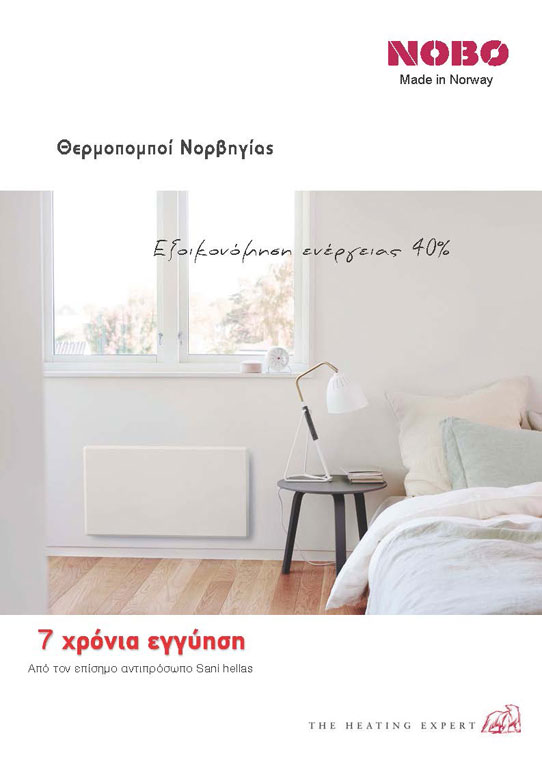
Frequently Asked Questions Dehumidifiers, Air Purifiers, Heaters
Frequently Asked Questions
Compressor dehumidifiers
Desiccant dehumidifiers Kullhaus and Meaco
Choosing the Right Dehumidifier
Faq
Advantages - How it works
Nobo
Atlantic
General Information
Filters Cleaner - Ionizer
Air Purifier Kullhaus AERO Ionizer
Air Purifier Kullhaus AERO+ Ionizer
Frequently Asked Questions
The dehumidifier is the device designed to reduce the amount of moisture in the air of the room - house. The dehumidifier helps us keep humidity levels in the room under control so that the air is more "comfortable" and hygienic, and the natural – visible signs of moisture, such as mold on the walls or condensation on the windows, are limited or disappear.
Some houses may have moisture problems only at certain times of the year, such as in the spring, when there is a lot of water runoff from the ground. Other houses present a high humidity problem throughout the year. A typical example is the humidity that occurs in northern walls and wardrobes, the condensation of moisture [drops of water] on the windows, the appearance of mold in the bath, in areas that are not properly heated or ventilated. There are also times when moisture is a problem only in a room or area of the house that is either not properly insulated or there are construction defects.
Dealing with high humidity is not just an aesthetic problem. It is mainly the prerequisite for the maintenance of the house. But the main thing is, and it should be emphasized, that maintaining the right level of humidity in your home, is decisive for the quality of life of the family at home. While humidity at normal levels can be beneficial, high or excessive humidity could be dangerous to your health. It is a typical example, nowadays, when the heating of the house during the winter months is very incomplete or non-existent for many households, children to catch cold often and repeatedly, creating painful conditions and weakening of the body, which can lead to even more serious health problems. See only the frequency that children are absent from school due to a cold. High humidity and the presence of mold can be the cause of allergies!
The dehumidifier is therefore the device that removes from the house excess moisture and keeps it at normal, healthy levels. The use of a dehumidifier preserves the house, creates the conditions for a healthy living environment, prevents diseases due to high humidity such as allergies, asthma, etc. Finally, without a doubt the use of a dehumidifier at home reduces heating costs by at least 20%.
What a dehumidifier does is to reduce the relative humidity of the air by removing the relative humidity from the air.
Whether you will have moisture condensation or otherwise condensation of water vapor (blur and drops of water in the windows) in the window is a relationship between the three factors:
- Air temperature
- The temperature of the glass surface
- The relative humidity of the room
The dehumidifier can only directly affect one of them (it could affect to some extent the air temperature depending on the size of the room) . Let's say for example that the room temperature is 20°C and the relative humidity is 55%. As long as the temperature on the window remains at 12°C, no condensation will form. But if the temperature of the surface of the glass drops below 12°C you will have exiled condensation, liquefaction of air. It is simple, the dehumidifier can keep the humidity of the room constant, but the winter - cold conditions make the glass colder at night and thus this creates condensation.
Humidity is something we hear every day in the weather reports. Humidity is the cause of the suffocating feeling we have some days of summer.
Humidity can be measured in several ways, with relative humidity being the most common. To understand relative humidity, it is useful to first understand the absolute humidity.
Absolute humidity is the mass of water vapor divided by the mass of dry air in a volume of air at a given temperature. The warmer the air, the more water it can contain.
Relative humidity is the ratio of the current absolute humidity to the highest possible absolute humidity (which depends on the current air temperature). A reading of 100 percent relative humidity means that the air is completely saturated with water vapor and cannot hold extra water vapor, creating the possibility of rain. This does not mean that the relative humidity must be 100 percent in order for it to rain – it should be 100 percent where clouds form, but the relative humidity near the ground could be much less.
People are very sensitive to moisture as the skin depends on the air to get rid of moisture. The process of sweating (sweating) is your body's effort to cool off and maintain its current temperature. If the air is 100% relative humidity, sweat will not evaporate into the air. Therefore, we feel much warmer than the actual temperature – given temperature when the relative humidity is high. If the relative humidity is low, we can feel much cooler than the actual temperature, because our sweat evaporates easily, cooling our body. For example, if the air temperature is 24 degrees Celsius and the relative humidity is 0%, the air temperature gives the feeling to our body as if it were 21°C. If the air temperature is 24°C and the relative humidity is 100%, we feel as if it is 27°C outside.
People tend to feel more comfortable at a relative humidity of about 55%. A dehumidifier will help keep the internal humidity at a comfortable level.
The recommended average relative humidity varies between 50% and 55%. This level of relative humidity provides the best comfort for your family, prevents the manifestation of allergies, frequent colds, bone pain, while at the same time helping to protect and maintain the house, such as plasterboard, walls and peeling of paint, wooden furniture, clothes in closets and other objects or materials that are prone to the harmful effects of excess moisture.
We use a dehumidifier when the relative humidity in the house is superior to normal, i.e. more than 55%. You can check the room humidity with a good quality hygrometer. If, of course, the humidity in the house is excessive, then the signs of mold and the relative smell that accompanies it will be obvious.
When there is too much moisture in your home, moist air is trapped in corners, basements and other enclosed spaces. This is often especially noticeable in the bathroom, when moisture is concentrated in corners and creates blackheads that are difficult to remove. Condensation of moisture can also be observed on the windows, causing the water to drip under the window and the wooden frames, resulting in rotting, while the wall that has been watered with water "bursts" and the paint to peel off.
Excessive moisture finally provides a perfect breeding ground for mold spores, bacteria and dust mites. Especially alarming about our health, which we often ignore. Dust mites live in your bed and reproduce faster when the relative humidity is above 60%. When the average relative humidity in Greece is 65% – 70% or more, you can see that there is really a problem. It is the feces to which people are allergic. Since they are in the air we can inhale them, as a consequence of which some people experience an allergic reaction. Mould spores are seeds that are released into the air to create even more mold and inhaling them can cause a serious allergy reaction in your respiratory system.
Mold grows when a material has a high moisture content (i.e. something that is wet or wet). The speed at which the mold develops is determined and determined by the relative humidity of the air. The higher the relative humidity, the faster the mold increases and spreads to a greater extent. That is why mold is most often found in bathrooms and utility rooms. Mold also likes cold walls with a small flow of air, which is why mold is often found on the back of cabinets or closets located on northern walls.
Condensation of moisture in Windows and Balcony Door
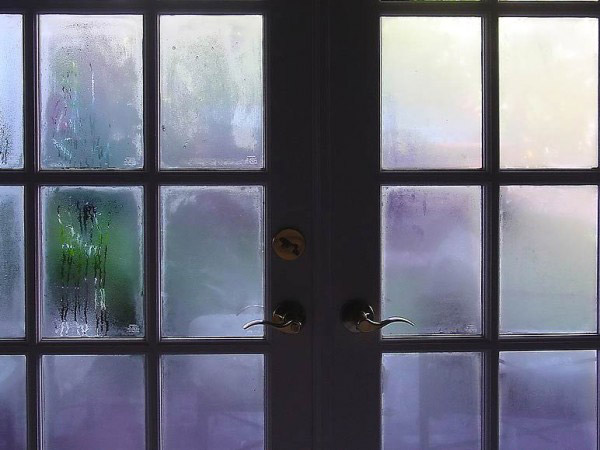
Condensation in the interior glass, dripping of water in the window or the presence of what looks like a fog or blur on the glass surface of windows or windows are typical indications that there is too much moisture in the room. The accumulation of moisture on the windowsill of a window, will result in rotting wooden inkill enclosures, the paint of the wall will peel off, and finally moisture will allow the development of mold. Mold, blackheads appear at the bottom of the window, or the balcony door.
Immediately turn off any humidifier that works and in the future, degrade the unit to reduce the amount of moisture outlet. When too much humidor outlet is the cause, the humidity level can correct itself simply by stopping using a humidifier and opening a window to add air circulation to the room.
Other things that can cause moisture to accumulate on the windows are the moisture present in the construction materials of the house, such as improper waterproofing of the wall drywall or moisture present in the cement. The climate outside the house can also cause moisture problems, such as when it rains for several days or the area where you live has a high humidity factor. A dehumidifier will effectively remove moisture from the house and restore moisture inside the house to the right levels. Remember to transfer the dehumidifier to all areas affected by excess moisture, and when the problem in them has moderated or disappeared to place the dehumidifier in a central place in the house, with the doors of rooms and cabinets open.
Mold spots on the ceiling or in corners of the walls
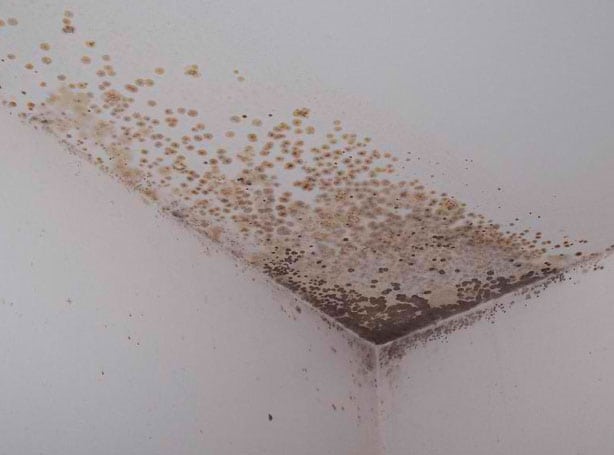
Because the steam rises, moisture problems in the bathroom are often found on ceilings or on the corners of the walls. Bathrooms that do not have effective ventilation to carry steam and moisture out of the house, most of the time have some problems with mold. Mold can develop on a wall, ceiling, under/around the toilet or behind the bath or on their perimeter shower.A leak in the toilet or plumbing can also cause moisture problems. Excess moisture can cause increased mold, which can in turn cause serious health problems. You don't have to see it mold in order to affect your health as long as it is just present somewhere.Other areas of the house that are often affected by trapped moisture are closets, basement, garages and storage areas.
The use of a dehumidifier in these areas can help. The dehumidifier will reduce the amount of damage caused by moisture, but the cause of the problem can not be ignored and the root of the problem should be addressed.
Mold spots in the bath
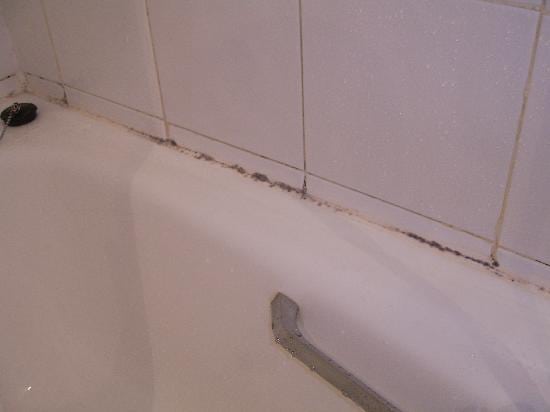
What is water vapor condensation, liquefaction? Confrontation.
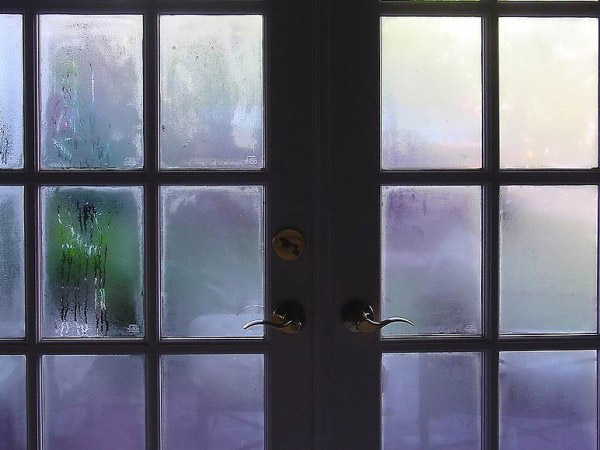
Condensation of water vapor on the windows is the humidity moistening in the window or the presence of what resembles a fog or blur on the glass surface of windows or windows. These phenomena are typical signs that there is too much moisture in the room.The accumulation of condensation of water vapor on the windowsill of a window or on the bottom of the glass window, will result in the rotting of wooden enclosures, the paint of the wall will peel off, the floor will swell, and finally moisture will allow the development of mold. Mold is none other than the blackheads appearing at the bottom of the window, or balcony door.
Installing new windows is obviously the solution (but not so practical, at least overnight! and certainly quite a costly solution). But even the installation of quality frames may not solve the problem or intensify it. The only solution is to reduce the humidity levels in the house with the use of a dehumidifier. In the event that and even then the moisture condensation remains, what you can do is to set the dehumidifier with a lower relative humidity, while leaving the heating (maintenance temperature) for some time during the night. This will stop the drop in room temperature (as the temperature drops, the relative humidity increases). You can also leave the curtains open to allow more air circulation around the window (especially useful if the door of the room remains open and the dehumidifier works at night).
Which method to choose in order to remove moisture from the air depends on the severity of the problem, the season and the point where there is moisture. If it is winter and a room could benefit from the heat, then heating this space could help to have a suitable level of humidity.
However, if the humidity is excessive you may need the combination of the two, heating and dehumidifier in order for the humidity to reach the right levels. A damp bathroom can benefit from an open window, or good ventilation to drive the humid shower/bathtub air out of the house. In combination with ventilation or in the case of non-ventilation, the use of a dehumidifier is the best and most effective option for removing moisture from the house.
This is indicated only on sunny summer days, but in winter the opening of the windows will simply lead to the loss of heat of the house. That's a waste of money. When it does not rain the result will be more moisture will enter the house.
When using a dehumidifier to check the relative humidity in your home you should NOT have the windows of the house open! On the one hand, the dehumidifier will not stop working, trying to dehumidify the space outside the house. Secondly, our goal is to keep the outside moisture out of the house. In the event that we want to ventilate the house in the morning, we can do it for a while, first extinguishing the dehumidifier. It's as if you had in operation the heating with open windows. When we are done with the ventilation of the house, then we put the dehumidifier back into operation.
It is common to observe a pronounced moisture problem in a particular room, usually in the northern part of the house. In this case, first place the dehumidifier in this room [generally in the room that presents a severe moisture problem and close the door]. When the moisture problem disappears, place the dehumidifier in some central part of the house, a head ladder if it is a maisonette or a hallway that connects the living room with the bedrooms.You should know that moisture has a tendency to move naturally to the dry places, that is, the dehumidifier. We recommend leaving all the doors of the rooms open, as well as the sheets from the wardrobes, so that the dehumidifier can pull moisture from all over the house. At the base of the square meters of the house you need to carefully choose the appropriate dehumidifier.
- Do not use the device without the air filter.
- To avoid problems and for the better operation of the dehumidifier clean the filter (with a vacuum cleaner and not with water) at least every other week.
- Do not use the device with a faulty cable or plug if it malfunctions or has fallen or has been damaged.
- Return it to an authorized service for inspection and repair.
- The device should always be in an upright position to avoid damage.
- Place the device on a flat and stable surface.
- Check the voltage in order to be the correct one.
- Use the dehumidifier for the appropriate temperature range that is built to operate.
- Make sure that the air inlet and outlet is not blocked or covered.
- Do not place the device too close to curtains or other objects – minimum 50 cm.
- When using the dehumidifier to dry clothes, keep the clothes at a safe distance from the device so that water does not fall inside.
- Never put anything on top of the device and do not cover it with any hardware while in operation.
- The device is intended for domestic and "light" office use ONLY and not for commercial, industrial or outdoor use.
- Do not immerse the device, plug or cable in water or other liquid.
- Never unplug the plug without first having switched off the device with the button off, as this can damage the device.
- Always unplug the device when it's not running or when you move it.
- Grab the plug and pull from the outlet. Never pull the cable.
- Do not remove the water container when the Dehumidifier is in operation, as water can be poured.
- If possible avoid the use of an extension, as it can overheat and create a fire hazard.
- Use only good quality and in good condition extension.
- Always empty the water tank to drain when you want to store the device.
- Close supervision is necessary when the device is in use or is close to children and pets.
- Do not pass the wire under carpets.
- Place the cable so that there is no risk of someone stumbling.
- To store the dehumidifier empty the water container. Let the container and dehumidifier dry completely, this can take a day or two.
- Store the device in a dust-free space, away from the sun, and preferably covered with nylon.
- To repair the device, please contact an authorized service.
When you first use the dehumidifier in a space, it will work harder – to reduce the relative 'room humidity' to the desired one' you have chosen (e.g. 55%). It makes perfect sense that "this is the moment" when it will produce the most water and the emptying of the container will need to be more frequent. As the room becomes drier the Dehumidifier collects less water and the filling of the container is slower. It is also logical that when the desired "relative 'humidity' is achieved, the Dehumidifier will stop collecting water." Therefore, the collection of less water is not an indication that the yield of the dehumidifier has decreased. It is a result of the fact that the Dehumidifier maintains at constant levels the humidity of the space, without having to work long hours, and therefore with less power consumption.
In order to keep the dehumidifier in good condition, its performance is maximum and to extend its service life, all you have to do is check the filter often and clean it according to the user manual. If the dehumidifier works on a permanent basis, the filter can be clogged with dust and particles.
• The filter should be cleaned every two weeks.
• Never use the device without the air filter!
• Tip: place the dehumidifier on a piece of furniture with a fixed and flat surface and not on the floor.
To clean the dehumidifier turn it off and remove the plug from the outlet.
The outer part of the dehumidifier
Clean the outside of the device with a soft, dry cloth. If the device is extremely dirty, use a mild cleanser. Wipe the device with a slightly damp cloth. Never spray the device with water.
The air filter of the dehumidifier
If used frequently, the filter can be clogged with dust and particles. That's why the filter should be cleaned every two weeks. Follow these steps:
• Remove the filter.
• Clean the filter with a vacuum cleaner and not with water. Cleaning the filter with water will destroy the anti-bacterial nano-silver properties of the filter. Frequent cleaning of the air filter is a prerequisite for the good and long-term operation of the dehumidifier.
All Kullhaus dehumidifiers have sensors and smooth operation fuses. In the event that either the water tank of the dehumidifier is not properly installed or filled during operation, then automatically the device will stop working, makes a characteristic noise and an indicator light turns on to alert you.
It is possible to connect the dehumidifier with a tube for continuous flow of water into the drain. Just connect the tube to the special socket of the dehumidifier and make sure that the other end of the pipe ends up in the drain. The tube should be flowing so that the water flows down to the drain.
Therefore, in order for there to be water flow, the dehumidifier should be placed at a relative height from the floor, in order for the tube to have a downward position.
Also make sure that the tube is not blocked, so that the water flows freely down. Otherwise, the water will not flow from the dehumidifier to the drain, but will accumulate in the water tank.
Kullhaus dehumidifiers include a tube in the package.
In Kullhaus Qualis dehumidifiers, the water tank and the lid have been designed in such a way that in the first place they are easy to use in everyday life. In many dehumidifiers you will see that it is difficult to get out the water container or gnaw in the attempt to take it out, as a result of which water or splashes are poured on the floor. At Kullhaus we have solved this problem with the easy placement and removal of the water container.
Secondly, it is very important that the water container is completely watertight and of very good quality. We have given special attention to the quality of the plastic and the perfect fit that have a lid and a water container.
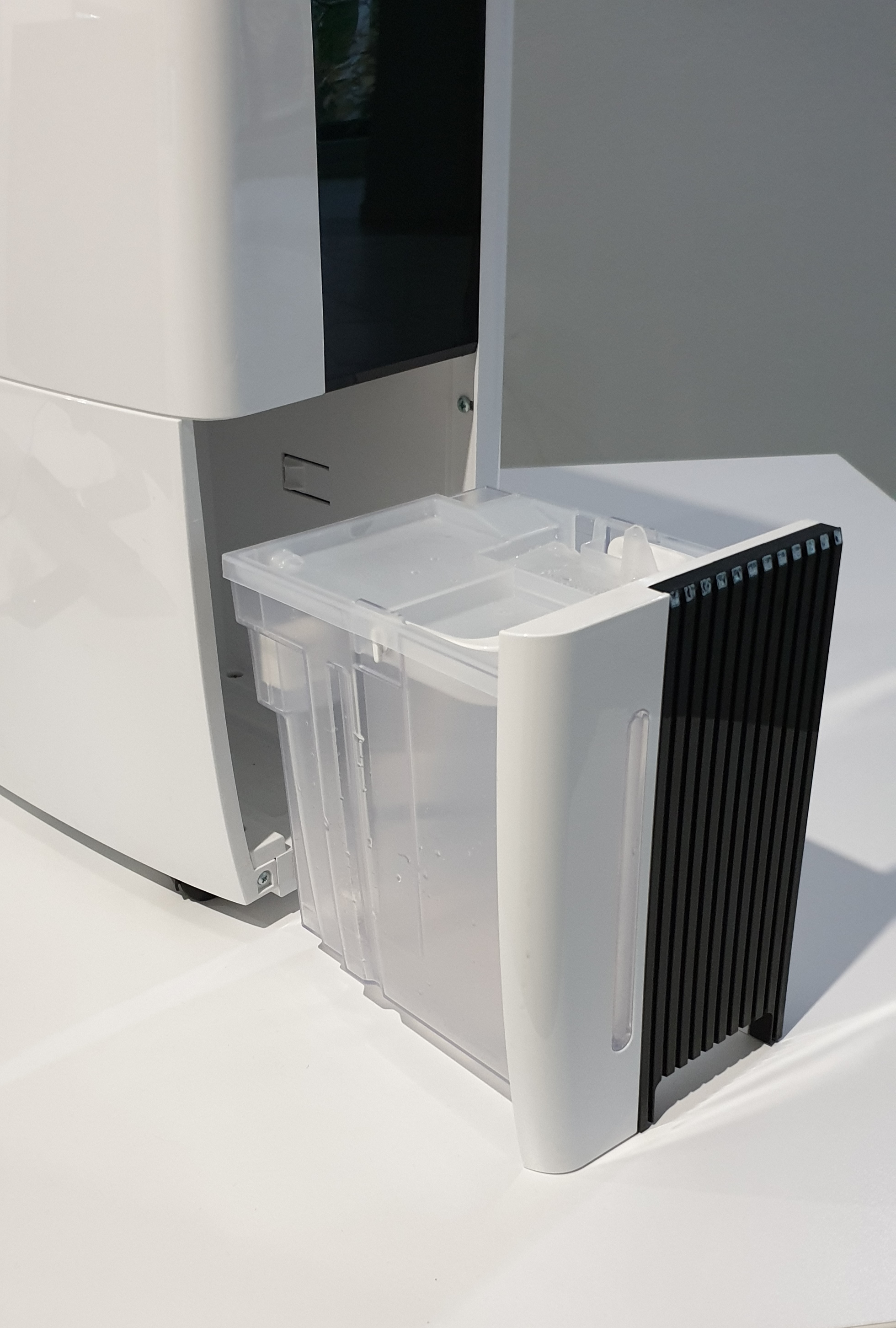
If the device will not be used for a long time, follow these steps: Remove the plug from the outlet and empty the water tank. Let the container and dehumidifier dry thoroughly, this can take a couple of days.Clean the air filter with a vacuum cleaner and not with water.Store the device in a dust-free place, away from the sun, and preferably covered with nylon.
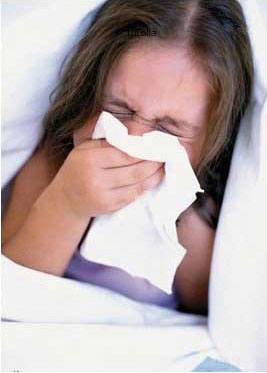
A large part of the population (up to 35%) at some point will experience symptoms of some form of allergic reaction. This is obviously a high percentage. Even more impressive and alarming is the statistic that about 50% of children have been diagnosed with an allergic condition. The substances that cause allergies are called allergens and these can be Food or Environmental. The most common environmental causes of allergies are:
• Pollen from trees or grasses
• Mold spores
• Dust mites
• Fungi
• Dust of the house
The danger of an allergic reaction, as well as the effect of each allergen, differs from person to person: from simple mild irritation, to life-threatening symptoms. In this article we will refer to airborne allergens, that is, those that cause respiratory allergy and are obviously in direct relation to humidity levels, in other words dust mites and mold spores.
Moisture contributes to the onset of respiratory allergy
Moisture conditions create mold
Dust mites live in your bed and reproduce faster when the relative humidity is above 60%. When the average relative humidity in Greece is 65% – 70% or more, you can see that there is really a problem. It is the feces to which people are allergic. Since they are in the air we can inhale them, resulting in some people having an allergic reaction.
Mould spores are seeds that are released into the air to create even more mold and inhaling them can cause a serious allergic reaction in your respiratory system. Mold grows when a material has a high moisture content (i.e. something that is wet or wet). The speed at which mold grows is determined and determined by the relative humidity of the air.The higher the relative humidity, the faster the mold increases and spreads to a greater extent. That is why mold is most often found in bathrooms and utility rooms. Mold also likes cold walls with a small flow of air, which is why mold is often found on the back of cabinets or closets located on northern walls.
It is obvious why a Kullhaus dehumidifier contributes and has a direct beneficial effect on the home in order to create a healthier environment. But what about the other airborne filth like pollen and dust?
The dehumidifiers Kullhaus Qualis 12L ion, Kullhaus Qualis 20L ion and Kullhaus Qualis 25L ion include an ionizer that will have a beneficial effect on dust restriction in the immediate environment.
The ionizer produces negatively charged ions, which attach to dust particles found in the air (invisible to the naked eye), become heavier than the air around them and fall to the floor and are finally vacuumed. In this way, harmful particles can be removed from the air without entering it again.
Platinum series Meaco dehumidifiers have a HEPA filter
Meaco Platinum dehumidifiers can accept a HEPA filter, which offers an even higher level of air purification. The HEPA (High Efficiency Particle Arresting) air filter is made of very tiny glass fibers, which have been converted into a densely woven paper. This creates a filter consisting of a multitude of very small "sieves" that can capture extremely small particles, including some biological elements. Once pollutants and particles are trapped in the filter, they are not able to flow back into circulation due to the high absorbency resources of the HEPA air filter. It is no coincidence that almost all air purifiers use a HEPA filter. For dehumidifiers, however, the situation is different. Meaco is the first company in Europe to create and combine for the first time quality dehumidification and air purification with a HEPA filter in one device. We refer to the new Platinum range of dehumidifiers and includes two models: Meaco 12L Platinum and Meaco 20L Platinum.
First and foremost, we are talking about true HEPA filters, and not imitations that call themselves "almost HEPA" "hepa-like" (or other similar and unclear terms). The actual HEPA filter meets strict international standards and retains really small particles that would otherwise escape from other (less sophisticated) filtration systems.
The starting point and the most important factor for the selection of the appropriate dehumidifier is the room temperature.
Click here to see the dehumidifier buying guide
Compressor dehumidifiers
Dehumidifiers with compressor Kullhaus Alpha Q13L, Alpha Q20L, Qualis 12L ion, Qualis 20L ion & Qualis 25L ion
Compressor dehumidifiers have been the standard way to deal with moisture problems for more than 40 years. You will notice that the Greek market is flooded with dehumidifiers with compressor of various companies, possibility of dehumidification, quality and price.
Kullhaus has in its range the dehumidifiers Alpha Q13L, Alpha Q20L, Qualis 12L ion, Qualis 20L ion and Qualis 25L ion. Qualis models are digital dehumidifiers ionizers. Kullhaus dehumidifiers adhere to three basic principles: low power consumption, quiet dehumidifier, aesthetic simplicity of a modern household appliance.
Dehumidifiers with Kullhaus compressor, Qualis ion series
Dehumidifiers with low-power Kullhaus series Kullhaus series compressor are perhaps among the most important household dehumidifiers launched in Europe in recent years. They set a new benchmark for build quality, energy efficiency, dehumidification capacity and quiet operation.
Read about the smart energy-saving function KULLSAVE Energy Saving System
The dehumidifier with compressor [compressor] sucks the air from the room with the help of the fan it has, filtered by the filter and directs it to liquid coils, similar to those of the refrigerator. The compressor compresses coolant gas which reduces the temperature of the condenser, the coils are cooled, resulting in the air cooling well below the dew/liquefaction point, resulting in the water vapor contained in it being converted into water (condensed) and flowing towards the dehumidifier's water tank. Then the dry air is heated to the levels of the room temperature and exits the dehumidifier in the room.
How does the compressor dehumidifier work?
1. How many square or cubic meters it covers
2. What is the possibility of dehumidification (liters of water / day) and especially at what room temperature and at what percentage of relative humidity
3. What is the actual consumption of the dehumidifier?
4. Does the dehumidifier have a hygrostat? Is it accurate, digital?
5. What is the noise level? Try to listen to the dehumidifier in operation before you buy it!
6. Does it have a clothes drying function?
7. Does it have an antibacterial dust filter?
8. Does it have a restart function after a power outage?
9. Does it have a built-in ionizer or HEPA filter?
10. Does it have an indication of a full container and its poor placement?
11. Does it have the possibility of permanent drainage and a tube included in the package?
KULLSAVE Energy Saving System - The Intelligent Energy Saving Mode
Low consumption dehumidifiers Kullhaus Qualis
When the relative humidity target you choose has been reached, the Kullhaus dehumidifiers will only operate the fan 3 minutes to check that the relative humidity is at desired levels. Then their operation will stop for 17 minutes. Then the fan will be switched on for 2 minutes in order to check the relative room humidity. If the relative humidity has increased above the predetermined level, the dehumidifiers kullhaus begin to work again. If the relative humidity remains below the predetermined level then the Kullhaus dehumidifiers will be put to sleep for an additional 17 minutes.
The 13 Litre dehumidifier, Kullhaus Alpha Q 13L with the lowest consumption in Europe. Only 145W.
The 20 Litre dehumidifier, Kullhaus Alpha Q 20L with the lowest consumption in Europe. Only 245W.
The 12 Litre dehumidifier, Kullhaus Qualis 12L ion with the lowest consumption in Europe. Only 170W.
The 20 Litre dehumidifier, Kullhaus Qualis 20L ion with the lowest consumption in Europe. Only 250W.
The 25 Litre dehumidifier, Kullhaus Qualis 25L ion with the lowest consumption in Europe. Only 290W
Desiccant dehumidifiers Kullhaus and Meaco
Dehumidifier with zeolite is a relatively recent dehumidification technology. This is the new way to combat humidity in houses with a low room temperature, where the "traditional" dehumidifier with a compressor is inadequate and ineffective. This is the technology based on the properties of the volcanic mineral Zeolite, the composition of which allows the absorption of moisture. Zeolite is a natural, extremely porous and by extension highly absorbent material, which acts as the means of dehumidification.
dehumidifier with zeolithos | mode of operation
The Kullhaus DDQ10L zeolite dehumidifier sucks the room's humid air・ the air is filtered by the pre-filter and activated carbon filter and driven to the rotating wheel filled with the dehumidifiable material Zeolite. The drying material absorbs excess moisture and the drops end up in the special container of the dehumidifier, where the water is collected.The thermal resistance of 420/720W and the fan inside the dehumidifier channel warm air onto the Zeolite, removing the moisture that has accumulated. The goal is for Zeolite to dry out so that it constantly absorbs excess relative moisture. The air diffused in the room by the dehumidifier with zeolite is dry and 10-12°C warmer than the room air that entered the dehumidifier.
IMPORTANT: The desiccant technology dehumidifier is important to cool inside after dehumidification. To release the heat that has been generated during operation. That's why the fan continues its operation for 2 minutes. Never unplug the dehumidifier until the dehumidifier operation cycle is complete.
Desiccant technology dehumidifiers perform 100% at low temperatures
The big advantage, compared to dehumidifiers with motors, is that the dehumidifiers Kullhaus and Meaco of new desiccant technology work efficiently at the most adverse temperatures of 1-37 °C! You should know that the performance of a dehumidifier depends on the temperature of the room where it is used. That is the determining factor. So, if the room temperature is below 15°C, the dehumidifiers Kullhaus and Meaco desiccant technology are the only ones that can operate without reducing their efficiency. Mainly country houses, for a long time closed, without ventilation and heating.
Desiccant Kullhaus DDQ10L and Meaco DD8L dehumidifiers guarantee dehumidification of 8-10 liters per day without exception of room temperature.
Desiccant dehumidifier blows warm air
At the same time, desiccant Kullhaus and Meaco dehumidifiers have thermal resistance inside, which heats the dry air before channeling it into the space. The desiccant dehumidifiers Kullhaus and Meaco raise the room temperature by 1-2°C, contributing to its heating.
Desiccant dehumidifiers work quietly
Precisely because the desiccant Kullhaus and Meaco DD8L dehumidifiers do not have a compressor, they are silent in their operation. Almost as silent as the Kullhaus Qualis ion.
Desiccant dehumidifiers have low consumption
The dehumidifiers desiccant Kullhaus and Meaco have low consumption (30W when the fan makes a diagnosis of the relative room humidity, 330W when the dehumidifier operates by dehumidifying and 650W when it is in operation). They have a built-in space humidifier, so as soon as the relative humidity of the space is achieved the dehumidifier is put out of service and does not consume any electricity, reducing the operating costs to a minimum. The fan of the desiccant Kullhaus and Meaco DD8L dehumidifiers come into sleep mode, and after about 30 minutes they will work again by taking samples from the air of the room and if the relative humidity has not increased then they are put back into a state of sleep.In a well-insulated house the fan will work for just 10 minutes an hour instead of 60!
It should be emphasized that the above-mentioned consumption includes the thermal resistance available to the desiccant Kullhaus and Meaco dehumidifiers, which increase the room temperature by about 1-2°C. The dry air blowing the desiccant Kullhaus and Meaco dehumidifiers is about 10°C warmer than the existing room temperature!
The only dehumidifiers operating at low temperatures of 1-37°C!
In most of the cases the function recommended is "Normal" and the first fan ladder. will maintain the relative humidity at about 50%. To avoid drops of moisture in the single-insulated windows or when the temperature drops below 5°C you should prefer the Maximum mode to the Normal.
When using the dehumidifier for the first time, and then, you may periodically notice a smell coming out of the dehumidifier. This comes from the dehumidifying material Zeolite desiccant and is not an indication that the dehumidifier is defective, or that it is harmful to humans or pets. The smell arises from the fact that Zeolite absorbs smells from things like cigarettes, cosmetics, hairspray, building materials and new furniture, and then when the desiccant is heated the smell is released into the room. The smell is reminiscent of something burning or like a sour smell. It is normal, does not last long and is not an indication of a faulty device. When storing the dehumidifier put it in its box for protection from dust.
When the selected relative humidity has been reached the dehumidifier will stop the dehumidification of the air, but the fan will work. When this happens the device will stop collecting water, it is normal.The fan continues to work in order to get a sample from the air so that the dehumidifier knows when to restart the water collection, but if the relative humidity is below the desired one then there is no need to collect water and of course no water will appear in the container. When the relative humidity again exceeds the desired limits, the dehumidifier will be switched on automatically.
The fan cools the inner radiator, it is normal. The fan will work for 3 minutes from the moment you press the Power button to turn off the device. Wait for the fan to stop working to move the dehumidifier.
-> never unplug the desiccant dehumidifier while the fan is running [cool down mode]
-> never use the desiccant dehumidifier with an outlet timer. It will shut down the fan and damage the zeolite wheel.
Choosing the Right Dehumidifier
The starting point and the most important factor for the selection of the appropriate dehumidifier is the room temperature.
Click here to see the dehumidifier buying guide
Choose the right dehumidifier based on the square of the space you need to cover. Two factors determine how many square meters a dehumidifier covers. So many liters of water can be collected by the compressor per day [12L or 20L] and the airflow, i.e. the power of the fan in how much volume of air it can move, and therefore the device can dehumidify.
Kulhaus Alpha Q 13L - covers up tp 80 sq.m.
Kulhaus Qualis 12L ION - covers up to 80 sq.m.
Kulhaus Qualis 20L ION - covers up to 130 sq.m..
Kulhaus Qualis 25L ION - covers up to 150 sq.m.
Dehumidifiers with compressor
It is the established way of dealing with moisture problems for more than 40 years. They act by creating a cold surface, and when warm and humid air from the rooms comes into contact with the cold surface, forms of condensation are created and the water is removed from the air.
Desiccant dehumidifier
The desiccant dehumidifier (with dehumidifier) does not have a motor-compressor and does not use a cold surface to remove excess moisture from the air. Instead it has a wheel with desiccant dehumidifier (zeolite) that absorbs moisture from the air, in a similar way to a sponge. The desiccant material is regenerated by an internal thermal resistance, so that the process can be repeated again and again.
Many customers prefer desiccant dehumidifiers because they are lighter and quieter in operation, due to the lack of the compressor. Also, the fact that desiccant dehumidifiers blow dry and hot air helping to heat the space is another element that many customers rate as positive. But there are other things to consider, the following following can help.
The only suitable one is the desiccant dehumidifier.
If you want to use the dehumidifier in a room, room or house where the air temperature is likely to drop below 15°C, then you should buy a desiccant dehumidifier. Anything else just won't work. This is because the inside of the dehumidifier with a compressor should be colder than the air inside the room. The colder the room, the more the dehumidifier will have to work in order to create the cold surface inside. As the temperature begins to fall downwards, close to 10°C, then chances are that the inside of the dehumidifier will reach near the freezing point, thus increasing the chances of ice forming in the cooling coils of the dehumidifier. This is why below about 15°C, compressor dehumidifiers are programmed to spend up to two-thirds of their time in defrosting rather than dehumidifying mode. Desiccant dehumidifiers on the other hand have a consistent performance regardless of the room temperature.
For use in low temperature areas – the winner is the desiccant dehumidifier
Most customers are looking for a dehumidifier to relieve them of moisture condensation (condensation: blur and drops of water on the windows).
The air coming out of the dehumidifier with a compressor will have exactly the same temperature as the room air, while the air coming out of a desiccant dehumidifier will be about 10-12°C warmer, a fairly large difference between the two. So, if for example you put the dehumidifier in a hallway that is on the cold side of the house, then the desiccant dehumidifier makes sense, since on the one hand it works at low temperatures, on the other hand it will warm the hallway.If now the treadmill is heated correctly, then the dehumidifier with a compressor could also be the right choice.
• Cold room – the winner is the desiccant dehumidifier
• Warm room – both types of dehumidifiers can be used
One of the most common reasons why people have problems with condensation and mold is because they dry clothes inside the house. When drying clothes, because the air around is drier, the moist air from fresh clothes is transferred naturally to the other places, so that it is in balance with its environment. So you can use a dehumidifier to dry clothes quickly, ensuring that there will be no phenomena of excessive moisture. All Meaco dehumidifiers have a separate laundry function (drying clothes). Drying clothes with the help of the dehumidifier works in the same way as when spreading clothes out in the summer.
As clothes will dry out faster when the day is dry, warm and blowing breeze, in the same way they will dry out faster if the warm and dry air from the dehumidifier hits the clothes.Desiccant dehumidifier tends to have a larger and faster airflow than a dehumidifier with a compressor, and as we have seen, the air coming out of the desiccant dehumidifier is warmer. Therefore, if you want to dry your laundry with a dehumidifier then the right choice is the desiccant dehumidifier.
Drying clothes – the winner is the desiccant dehumidifier
In general you should leave the dehumidifier in one place, and since the interior doors are open, the moisture in the house will migrate to the dehumidifier, until it is close enough to the fan of the dehumidifier to suck it.
However, there are some cases where you may want to move the dehumidifier. You may have built-in wardrobes in a bedroom that is on the north wall and is prone to mold growth. You may have the dehumidifier upstairs and need to be moved downstairs for drying clothes, or you may want to move it to an poorly ventilated bathroom or use it in the garage or storage room.
Dehumidifiers with compressor have an additional weight of about 6 kg. Therefore, the transfer of a desiccant dehumidifier is much easier, both because of weight and because of volume.
Move your dehumidifier – the winner is the desiccant dehumidifier
Faq
The heaters are thin electric heaters of direct efficiency panels, which operate through the natural flow of air (convection). The cold air located in the lower layers of the room enters from the bottom of the heater (natural attraction), is heated by the special resistance of the body and is forcibly extracted from the upper part of the heater, without drying the air. Heaters do not have a ventilator and should in no way be confused with common air heaters. The heaters do not blow hot air (they do not have a ventilator) unlike air heaters and air conditioners! On the contrary, they give rise to a sweet heat that diffuses into the space harmoniously through the natural flow of air.
The Nobo and Atlantic heaters have thermal resistance (cold resistance) and are shielded by aluminum! It more effectively diffuses the heat in the space, does not glow and therefore does not burn the oxygen of the atmosphere.
Nobo and Atlantic heaters are now known to the Greek public as a reliable, economical, efficient and hygienic heating system, established for decades in Europe and scandinavian countries.
Natural convection
Nobo & Atlantic electric heaters operate through the natural flow of air (convection hence convector). The cold air located in the lower layers of the room enters from the bottom of the heaters (natural attraction), is heated by the special resistance of the body and is forcibly extracted from the upper part of the heaters , without drying the air. The thermal resistance of the convector is armored by aluminum! It does not glow and therefore does not burn the oxygen of the atmosphere. Nobo and Atlantic heaters Nobo Norway is the largest Scandinavian firm specializing in heaters since 1947. Atlantic France is the largest European company when it comes to electric heating. Nobo and Atlantic heaters ensure the immediate and quality heating of the premises, as they maintain the atmosphere hygienic without drying it out (important for children, the elderly and people with respiratory problems and asthma).
Because there is a lot of confusion in the market today, and clearly a lot of misinformation, you should be aware of at least the following basics:
Heating panels are any electric heaters that is thin in thickness and placed on the wall. The heaters are therefore heating panels, which have the possibility of placement on the floor with special support treads.
There is no heater that makes hasty diffusion of heat (or has any such option to operate with a fan)! It is simple: the heater works through the natural flow of air, for this reason it is a healthy heating (it does not dry the atmosphere). heater and fireworker are two opposite modes of operation!
In no case should heater be confused with heaters! These are two completely different styles, which are explained below.
Also, heaters and heaters have nothing to do with infrared radiators and the magnetic waves they emit!
Finally, we often hear or read "how much the heaters consumes". It is impossible to make such generalizations and simplifications. Which brand of heater are we referring to? Doesn't the build quality count? If it has an electronic thermostat? The quality of the heating resistance? Is the required power of the convector calculated correctly based on area and ceiling height? Are the insulations of the house and the location taken into account?
Does the heater have quality certificates that ensure its safe operation? Does it have thermal safety that protects against overheating? Does it have a room temperature sensor? Does the thermostat have a space or simply the temperature of the heater?
Is the thermostat of the heater electronic or mechanical? An electric heaster with a mechanical thermostat will consume at least 30% more than another with an electronic thermostat. To understand if a thermostat is a mechanical (old technology that is, operating with bimetallic plates) fluctuate the temperature from the thermostat and when the heater turns on or off you will hear a click.Is it really silent in operation?What guarantee does it have? Does it have spare parts and service?
All electric heaters NOBØ & ATLANTIC are single-phase, 230V. They are of double insulation (Classe II), degree of protection IP24 and are placed fearlessly in the bathroom.
Heatrer power consumption in euro
| W | Power of the heater required to heat a space, at the base of the area, ceiling height, insulation, geographical location. |
| € | Price kilowatt-hour. |
| P.O | Periodic operation of a heater. From the moment (point in time) that the heater touches the desired room temperature that we have chosen from the electronic space thermostat. |
| H | Hours of heating body operation. |
| S.P. | Room heating starting point (room temperature before heating it). |
Heater consumption: To calculate the cost of consumption of the Nobo and Atlantic heaters we need to calculate the cost at the Starting Point (consumption cost until the radiator "catches" the desired temperature) and the Operating cost (maintenance cost of the desired temperature).
Heating starting point = W x P x S.P
Operating cost = W x P x H
Room heating of 12 sq.m. for 4 hours (Example of consumption)
• A 1500W heater is required
Ceiling height 2,80 – 3 meters
Good insulation (aluminum frames, double glazing, masonry insulation)
• Starting point
It takes 30 minutes to achieve the desired temperature
(20Cº is considered a hygienic room temperature)
• Operating costs
3.5 hours with consumption of 60% of the rated power, i.e. 0.9kW
During this time the heater will turn on and off automatically and quietly, maintaining with accuracy the desired temperature
• Price kilowatt-hour (Kw/h)0,10€
(reduced or nightly PPC tariffs are not counted)
(1.5 x 0.11 x 0.5) + (1.5 x 0.11 x 0.6 x 3.5) = €0.43 for 4 hours
• Do not place the heaters in places where air currents may be created
• Do not leave the heaters in operation during the hours you are away from home (if the time of absence is short, then just lower the desired room temperature). In any case, the nobø and ATLANTIC heaters have immediate performance and will heat your space instantly.
• The power of the heaters should be the correct one. For example, for a room up to 13 sq. m. place a 1500W radiator. If you choose less power, the heater will work much more, and in cases where the power is extremely disproportionate to the space and its insulation, it will never turn off!.
• The use of dehumidifiers reduces consumption in heating by 15-20%. You will notice how much more difficult it is to heat a house with high relative humidity (for example, when a house remains closed for a long time) and how much more expensive it is. You will see a huge difference in the immediacy of heating the house, but also in the cost of consumption if your house maintains the right levels of relative humidity. Important: desiccant dehumidifiers Kullhaus Meaco blow warm air, about 10C° warmer than room temperature.
For more information read the article “How to choose the right dehumidifier“
Are you still dealing with products of dubious quality and performance, technologically outdated?
- Does the heater have quality certificates that ensure its safe operation?
- Does it have thermal safety that protects against overheating?
- Does it have a room temperature sensor?
- Is the thermostat space or just the temperature of the heater?
- Is the thermostat of the heater electronic or mechanical? An electric radiator with a mechanical thermostat will consume at least 30% more than another with an electronic thermostat.To understand whether a thermostat is a mechanical (of old technology that is, operating with bimetallic plates) fluctuate the temperature from the thermostat and when the heater turns on or off you will hear a click.
- Is it really silent in operation?
- What guarantee does it have? Does it have spare parts and service?
The products of NOBØ and ATLANTIC have cold resistance, shielded in aluminum in order not to be burned. By extension, it does not burn the oxygen of the atmosphere. It should also be emphasized that heaters do not have ventilators! They don't blow hot air. They produce heat that diffuses harmoniously in the space. Studies show that one of the most important sources of indoor pollution are considered to be "heating devices, such as stoves, heaters, gas boilers, ovens, mangalia and fireplaces, in which wood, oil, natural gas, kerosene, etc., and various lighting devices (oil or oil lamps) are burned, depending on their type. The exhaust gases of all the above, when not extracted (removed), result in the emission of significant amounts of carbon monoxide (CO), carbon dioxide (CO2), sulphur dioxide (SO2), nitrogen oxides (NOx) and particulate matter.
In order for a heater to warm satisfactorily and immediately a space must meet certain conditions (see Technical Information). The calculation – choice of the correct strength of a heater is not an arbitrary decision. It is determined by the area of the space, the height of the ceiling, the peculiarities it presents (e.g. internal staircase, etc.), the insulation, the geographical location, etc. If these rules are followed then we will be sure that we will have immediate, correct and economical heating. If, for example, a space requires a power of 2000W and we place a heater of 1000W then this will neither heat satisfactorily and mainly will never turn off, consuming endlessly current without any real result! In conclusion, the NOBØ and ATLANTIC heaters do not have power levels because that would be completely useless! They have a room temperature sensor and an electronic room thermostat, with which we determine exactly the room temperature we want.
Each heater needs a separate line from the panel (except for 750W & 1000W which is low power). In the opposite case that two bodies are placed in a common line, then the security will fall. In other words, the Amper (A) of each safety in the panel determines the maximum power (W) that it can withstand. If it exceeds this maximum limit then the safety falls!
If, for example, we have a 10A fuse on our electrical panel, then this fuse can withstand up to 2200W. Let us now assume that from this safety leaves a cable which ends in two sockets. So these are non-independent sockets with a common line. In this case we can place a radiator in one socket and in the other some device that does not pull a lot of current, e.g. TV, radio, computer, portatif, etc.
It depends on how large (area) is the house we want to heat. It depends in other words on the number of heaters that will work at the same time. If the house is small then the single-phase (1F) current is sufficient. For a larger house where the single-phase clock of PPC with 35A (maximum power 7.700W) is not sufficient then there are the following solutions:
Increase the power of existing electricity supply (the safety Amper (A) of the single-phase clock of PPC). Conversion to a three-phase supply. If none of the above solutions are possible, then it is suggested to rotate the heaters, given the direct performance of the bodies. For example, during the day we operate the bodies in the living room and kitchen, while in the evening we turn them off and light those of the bedrooms.
In the case when the house is large enough, the three-phase supply is mandatory. Also, the sum of the strength of the bodies should be calculated in order to determine what collaterals (A) the three-phase (3F) should have. The study of the floor plan of your home undertaken by our company will fully inform you about the electrical needs required.
Advantages - How it works
Nobo

Nobo tradition to heating
Since 1938, NOBØ, based in Stjørdal Norway, has been manufacturing quality electric heaters. It is one of the largest manufacturers of convectors in Europe, with exports to 20 countries worldwide and is the largest manufacturer of thermal transmitters in Norway. Norway Nobo radiators were presented in Greece by our company about 30 years ago and immediately their reputation was identified with the quality of construction and reliable operation.
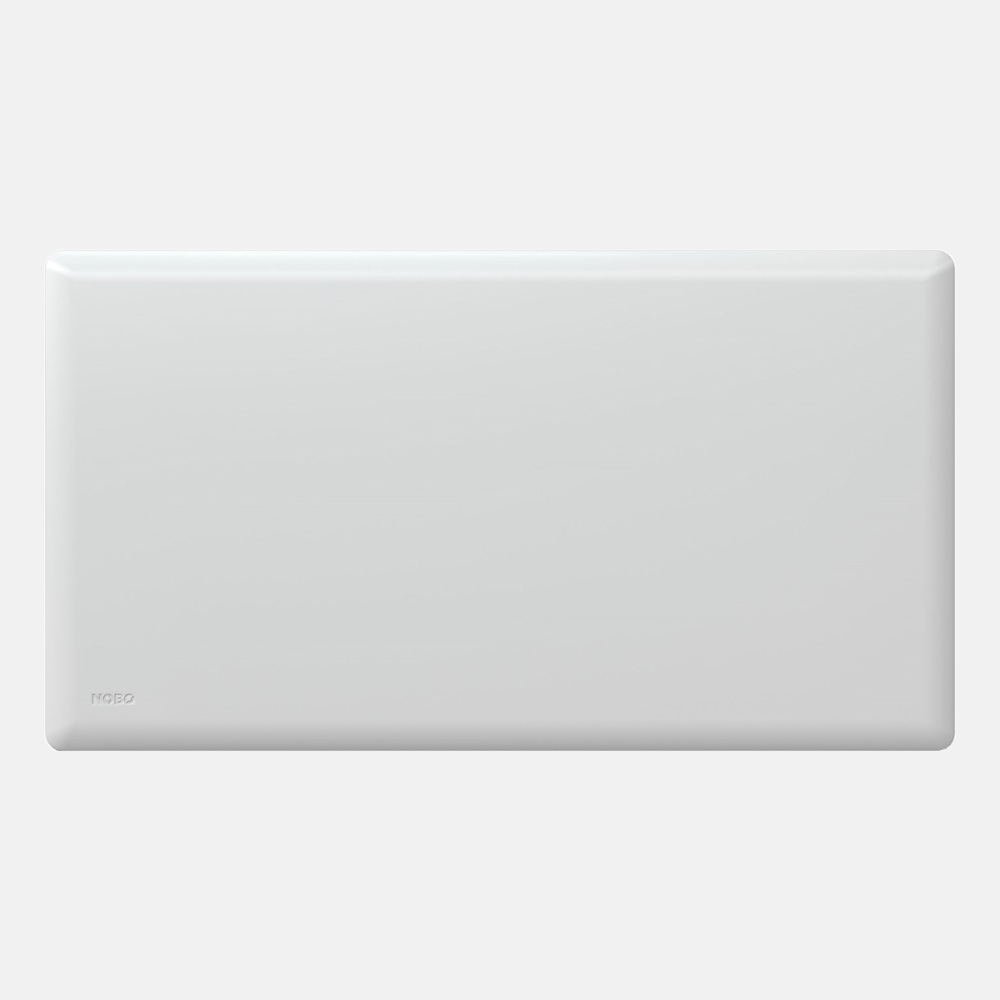
- The first electric heater was launched by NOBØ in 1938. Since then, NOBØ has become synonymous with quality, innovation and reliability.
- Traditionally the largest Norwegian manufacturer of electric heaters. Norwegian Nobo heaters have always been the top sellers in the Nordic countries and the top selling Norwegian heaters worldwide. To date, C4F series heaters alone have sold over 3 million units worldwide.
- You will not find cheap or expensive series of heaters, electronic or mechanical room thermostats at Norway NOBØ heaters. Norway Nobo heaters always have only an electronic precision room thermostat with a displacement of ± 0.05C °, cold resistance shielded in aluminum, perfect finish, electrostatic powder coating (the world-famous Norwegian paint Jotun is used).
- When you buy a NOBØ heater, you know you are buying a high quality product, manufactured and tested at the Stjørdal factory in Norway. NOBØ remains a constant guarantee of quality and reliability.
- Only 5.5 cm thick!
• Completely silent operation
Heaters of other companies make noise when the resistance starts to heat up and/or when it is heated and starts to cool. Nobo heaters make sure that they work completely silently.
• Built-in electronic space thermostat (deviation ± 0,05C°)
Norway Nobo heaters have the new NCU 2Te precision space electronic thermostat integrated, with a deviation of ±0.05C°! Immediate reaction to changes in room temperature, quiet operation, constant maintenance of the selected temperature, even greater energy savings.
• Sensor
• Instantaneous response of the thermostat to room temperature
The high quality of the Nobo thermostat minimizes any deviation between the selected temperature and the room temperature, resulting in maximum energy savings.
• Lower consumption, maximum efficiency, direct heating
Nobo heaters have an efficiency of 100%. This means that all the electricity consumed is converted into heat. That is, the body itself does not withhold heat, it delivers it to 100% in space.
• Even lower consumption in stand by <0,5W [ecoDesign]
• They do not dry the air
Norway Nobo heaters have high-quality cold resistance, shielded in aluminum in order not to be ignited. By extension, it does not burn the oxygen of the atmosphere. It should be emphasized that the heaters do not have a ventilator! They don't blow hot air. They produce heat that diffuses harmoniously in the space. The Nobo heaters are suitable for children's rooms, for the elderly and people with respiratory sensitivities.
• A large area means more harmonious heat dissipation and a higher rate of fire/heat emission.
Nobo's new NTL4T heater operates 80% through natural flow and 20% through heating (heat emission). It has been designed in such a way as to achieve a large surface for the emission and diffusion of heat. Accordingly, more homogeneous and more efficient diffusion of heating.
The new Nobo NTL4T heater model has smaller dimensions [width] and therefore a more practical size for installation in the house, on the wall or on a wheeled floor base.
• Heat dissipation from the top and back of the panel
The heat in the Nobo NTL4T heaters is diffused by the blinds located at the top and behind the body. Thus, on the one hand, a better diffusion of heat in the room is achieved, while the aesthetic result is really excellent, as the blinds are not visible from the façade of the heater.
It is important that the large, smooth and unblemished surface of the façade increases heat emission, as well as better and more harmonious heat dissipation in the space.
• Thermal safety protection against overheating
If the heater is accidentally covered (it is forbidden!) then the built-in thermal fuse within the body automatically stops its operation. Remove the object that covers the body and turn off the device for five minutes. Re-open the device and the body is reopening normally.
• Safety! Protection for children!
Even in Comfort (maximum) performance the outer surface of the body does not burn and is tolerated even at the touch of the child's hand. The natural airflow (convection) and the large surface of the body prevent the development of high temperatures on the outer surface of the convection.
Nobo's new NTL4T heater with its smooth surface is designed in such a way as to further reduce the temperature of the façade, making the convector even safer for children. Finally, the rounded corners are designed to avoid childhood accidents, while at the same time they are pleasantly harmonized with the environment.
• Double insulation Classe II, protection against water vapor (Splash proof)
Heaters are placed fearlessly in the bathroom.
• Only 5.5 cm
Sani hellas, as the official and exclusive representative of NOBO Norway in Greece and Cyprus, provides a 7-year warranty exclusively for all models of heaters that it imports and that have been purchased from the official distribution network nationwide (see points of purchase).
Following a directive by NOBO, for the protection of our customers and to continue to provide direct service, NOBO heatersw moving through para-importers in our country will not have the guarantee of the official representative.
Norwegian heaters NOBO official sales network Sani hellas
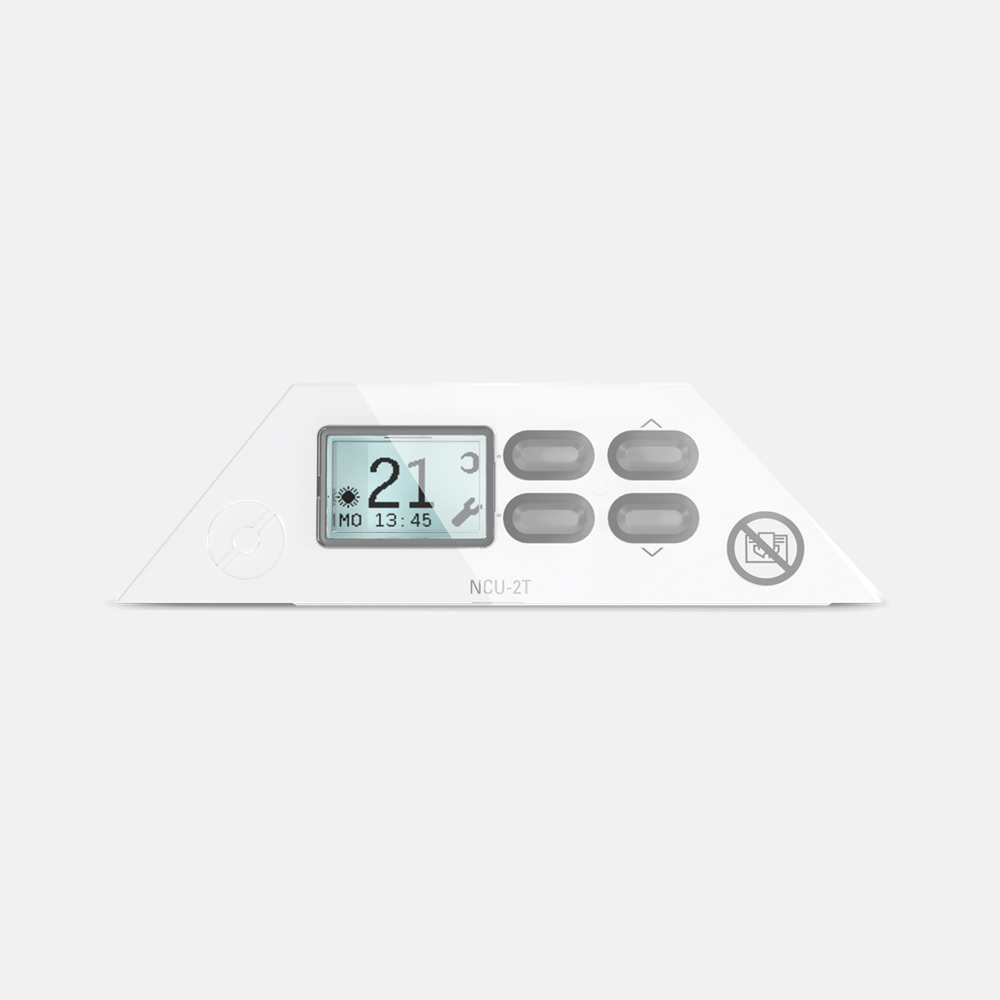
The new Nobo NTL4T heater has integrated the sophisticated NCU 2Te space electronic thermostat, which is the only one in the world that offers accuracy with a deviation of only ±0.05C° !
- Even greater energy savings
- Instantaneous response to room temperature variations
- Even greater comfort
- 9 Predetermined Programs
Norwegian Nobo heaters have been known for years to the Greek public for their quality and reliable operation. There are countless houses equipped with NOBØ heaters.
From island Greece to the most mountainous parts of Parnassos, Pelion, Vytina, Papigo and Karpenisi, NOBØ radiators enjoy blind trust.
Norway Nobo heaters offer instant heating, economical operation and hygienic warmth that does not dry out the atmosphere. Elements that clearly express all the advantages of a quality and clean heating system with heaters. After all, NOBØ has always been a guarantee for its products and the quality of construction.
- Sweet heat
- Quality of construction
- Low consumption
- 7 year warranty
In general, heaters are mounted on the wall. This is their natural position. But there are cases when there is no space available on the wall. In this case, NOBØ provides the possibility of placing the heaters on support legs with wheels.
The placement of NOBØ heaters on support treadles with wheels does not reduce in the least the efficiency, the quality of operation and the safety of the heater.
| Model | Power W | HxWxD cm |
|---|---|---|
| NUL4T 05 | 500W | 40 x 42,5 x 11,5 |
| NUL4T 15 | 1500W | 40 x 62,5 x 11,5 |
| NUL4T 20 | 2000W | 40 x 92,5 x 11,5 |
| NUL4T 24 | 2400W | 40 x 92,5 x 11,5 |
| Model | Power W | HxWxD cm |
|---|---|---|
| NTL2N07 | 750W | 20x102,5x5,5 |
| NTL2N10 | 1000W | 20x132,5x5,5 |
| NTL2N 12 | 1250W | 20x152,5x5,5 |
| Model | Power W | HxWxD cm |
|---|---|---|
| NTL4T 05 | 500W | 40 x 52,5 x 5,5 |
| NTL4T 07 | 750W | 40 x 62,5 x 5,5 |
| NTL4T 10 | 1000W | 40 x 72,5 x 5,5 |
| NTL4T 12 | 1250W | 40 x 92,5 x 5,5 |
| NTL4T 15 | 1500W | 40 x 102,5 x 5,5 |
| NTL4T 20 | 2000W | 40 x 112,5 x 5,5 |
Atlantic
Atlantic Heaters
ATLANTIC is by far the largest European firm specializing in electric heating. With sales exceeding 3 million radiators per year and 10,600 employees worldwide. It has 15 factories around the world, of which 9 in France. Atlantic has been manufacturing since 1968 radiators characterized by French elegance and discreet design in white color. The goal is always high quality, immediacy in tradition and affordable prices.
Sani hellas, as the official and exclusive representative of ATLANTIC France in Greece and Cyprus, provides a 5-year warranty exclusively for all models of convectors that it imports and that have been purchased from the official distribution network nationwide (see points of purchase).
On the instructions of Atlantic, for the protection of our customers and to continue to provide direct service, Atlantic radiators moving through para-importers in our country will not have the guarantee of the official representative. France Atlantic radiators official sales network Sani hellas
- Completely silent operation
- Built-in electronic space thermostat (deviation ± 0.1C°)
Immediate reaction of the thermostat to changes in room temperature, silent operation and constant maintenance of the selected temperature.
- Room temperature sensor
- Low consumption, direct heating
Atlantic radiators do not retain heat, they deliver it 100% to the space. The energy consumed in electricity is converted entirely into heat.
- They do not dry the air
The Atlantic radiators have cold resistance, shielded in aluminum in order not to glow. Therefore it does not burn the oxygen of the atmosphere and does not dry out the atmosphere.
- Atlantic radiators have small, practical dimensions for mounting on the wall or on a floor base.
- Heat dissipation from the front of the panel
Atlantic radiators dissipate heat from the blinds located on the façade of the body inclined downwards. The accumulation of dust inside the body is prevented, and the diffusion of heat in the room becomes more harmonious.
- Thermal safety protection against overheating
Atlantic radiators have thermal safety. So, if the radiator is covered (prohibited!) or overturned (when it rests on floor wheels) it automatically stops its operation.
- Safety!
The outer surface of the body does not burn and does not cause a burn. Atlantic radiators have been installed in many kindergartens.
- Double insulating Classe II, protection against water vapor (Splash proof)
Atlantic radiators are placed fearlessly in the bathroom
General Information

Negative ions are odorless, tasteless, and invisible molecules that we inhale in abundance in some parts of the environment. Think of mountains, waterfalls and beaches. Once our blood reaches, negative ions are believed to produce biochemical reactions that increase the levels of chemical mood of Serotonin, helping to address depression, relieve stress, and boost our daily energy.
Ions are molecules that have acquired or lost an electrical charge. They are created in nature as air molecules break down with sunlight, radiation, and the movement of air and water. You may have experienced the power of negative ions when you last went to the beach or walked under a waterfall. This sense of euphoria is simply around us and is offered to us by nature.
The air circulating in the mountain and the sea is said to contain tens of thousands of negative ions. Consider that the average house or office building contains dozens or hundreds of negatively charged ions, while in many cases their existence is zero.
At Columbia University of America, studies have shown that people with chronic depression are relieved by generators producing negatively charged ions, as much as antidepressants, but without the side effects of these!
"In general, negative ions increase oxygen flow to the brain, lead to higher alertness, decreased drowsiness, and more mental energy," says Pierce J. Howard, PhD, author of "The Owners Manual for the Brain: Everyday Applications from Mind Brain Research and director of research at the Center for Applied Cognitive Sciences in Charlotte, N.C.”
Negatively charged ions can also protect against germs in the air, resulting in reduced irritation due to inhalation of various particles that cause sneezing, coughing, or throat irritation. One in three of us who are sensitive to the effects of microbes in the air, negative ions can make us feel like we are flying.You are one of them, if you feel refreshed immediately the moment you open a window and breathe fresh, moist air.
"You may be one of them if you feel sleepy when you're around an air-condition, but you immediately feel rested and refreshed when you go out or when the car window opens," says Howard WebMD. "Air conditioning reduces in the atmosphere the number of negative ions, but a new ion generator releases the ions that air conditioners removed."
An in-depth investigation was carried out by Dr. Albert Krueger in California. One of his first discoveries was that a surprisingly small amount of negative ions could kill and remove from the air, the types of bacteria that cause colds, flu and respiratory infections.
- Inactivate viruses, bacteria, fungus.
- Neutralize air pollutants (dust, cigarette smoke, etc.)
- Revitalize the air
- Increase the flow of oxygen to the brain, giving greater vitality, energy, clarity and spiritual well-being. Fight drowsiness and help memory
- Improve physical endurance
- They help with symptoms of depression
- Improve sleep quality
- Facilitate breathing
- Strengthen the immune system
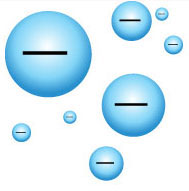
The ionizer produces negatively charged ions in the air of the room, which effectively remove polluting particles from the air, such as allergens (including mold and dust), dust microparticles, bacteria, viruses, chemical fumes and tiny particles that a filter cannot retain.
The ionizer increases the effectiveness of the HEPA filter and the activated carbon filter, as it causes the particles to be magnetically attracted, thus creating larger particles that are easier for the filters to retain.
It disinfects viruses and bacteria that are captured in the filters, and that would normally reproduce in the filters if the negatively charged ions were not present.
Finally, the ionization function has the ability to remove particles suspended away from the air purifier, in parts of the room air where the filter has little efficiency. This is because the ions circulate throughout the room. The circulation of negatively charged ions is enhanced by the operation of the fan of the air purifier.
Filters Cleaner - Ionizer
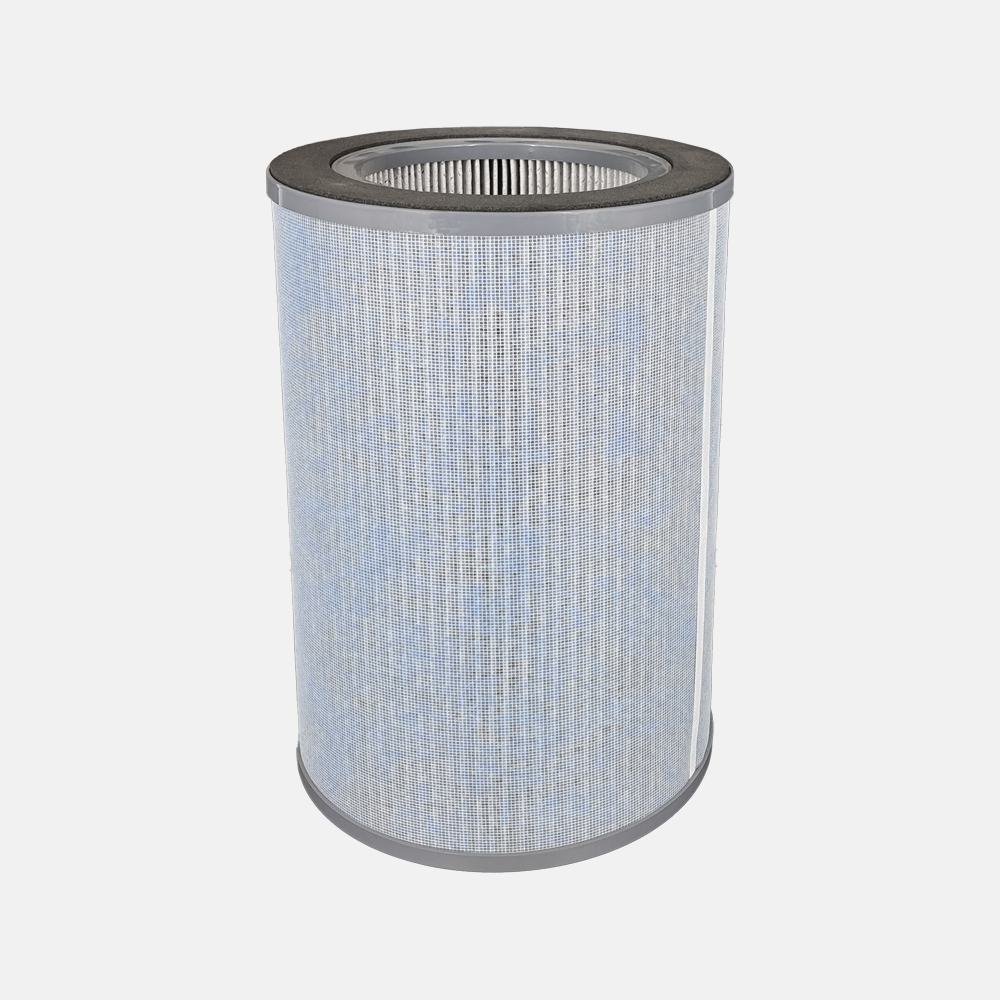
The HEPA (High Efficiency Particle Arresting) air filter is made of very tiny glass fibers, which have been converted into a densely woven paper. This creates a filter consisting of a multitude of very small "sieves" that can capture extremely small particles, including some biological elements.Once pollutants and particles are trapped in the filter, they are not able to flow back into circulation due to the high absorbency resources of the HEPA air filter.
The HEPA air filter removes more than 99% of the particles (0.3 microns) that pass through the filter, preventing them from recirculating into the air.The HEPA filter is widely regarded as the most effective type of filter in the retention of a large volume of suspended dust, dust mites, allergens, fungal spores (Alternaria spp., Cladosporium spp., Aspergillus spp.) and other particles such as bacteria, including many ionized particles that would otherwise fall to the floor if we used a common ionizer.
The activated air carbon filter consists of a system with pores of molecular dimensions. These pores are highly absorbent, forming a strong chemical bond/attraction to odors, gases and polluting liquids.
It is the best type of filter in the retention and neutralization of chemicals, gases, odors, volatile organic chemicals (VOC) and cigarette smoke, which the HEPA filter cannot retain.
Air Purifier Kullhaus AERO Ionizer
With the Kullhaus AERO air purifiers – ionizers you will be sure that your interiors will be clean of:
- Suspended particulate matter
- Dust / Dust mites
- Dead skin cells
- Pollen and other allergens
- Fungal spores
- Tobacco
- Cigarette smoke
- Dead pet cells
- Mold
- Fungi fungi fungi
- Chemicals
- Viruses
- Volatile organic compounds VOCs
- All organic chemicals and gases
- Stench and smells
- Bacteria and other microorganisms
Air purifiers – Kullhaus AERO ionizers
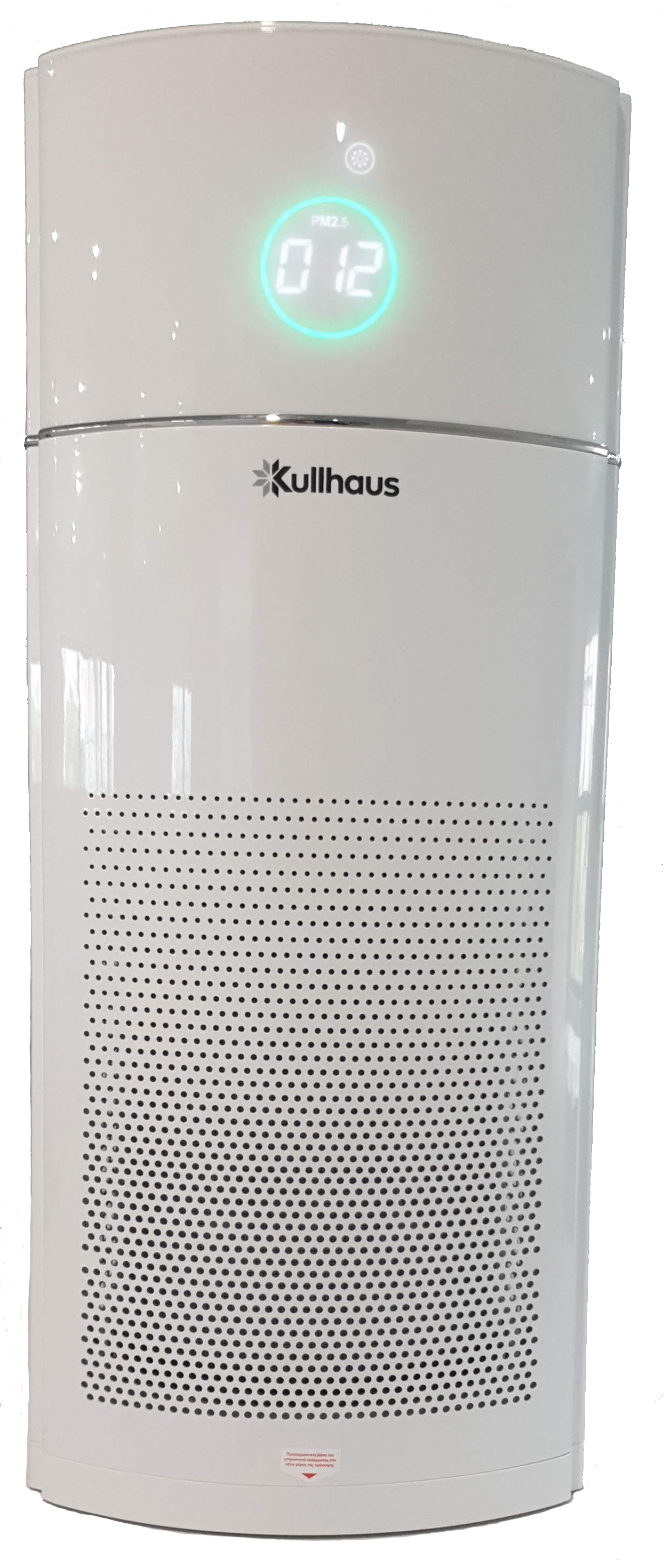
Clean air and quality of life
The Kullhaus AERO ionizers air purifiers ensure that the room air will be free of airborne particles smaller than 0.3 microns They ensure a healthy living environment and make a real difference in the quality of your life at home or workplace. Kullhaus air purifiers fight pollen, cigarette smoke, dust, dust mites, mold spores, pollution, viruses and bacteria, VOCs, animal dander
Just compare the CADR (CLEAN AIR DELIVERY RATE) results of Kullhaus air purifiers with other products in the European market.
CADR results
| Model | space up to | CADR (m³/h) |
|---|---|---|
| AERO | 45 sq.m. | 370 |
| AERO+ | 60 sq.m. | 495 |
Number of air changes according to Air Volume
Room air volume: Measure the length, width and height of your room in meters and multiply the three together to give you the cubic volume of air of the room [m³]. If the symptoms are mild, three times an hour, it will be fine, five times an hour, it will give better results. If your allergy is severe, you should calculate seven or eight times change of air per hour.
| Model | Number of air changes per hour | |||||
|---|---|---|---|---|---|---|
| Kullhaus AERO+ | 3 | 4 | 5 | 6 | 7 | 8 |
| 165m³ | 124m³ | 99m³ | 82m³ | 71m³ | 62m³ | |
| Model | Number of air changes per hour | |||||
|---|---|---|---|---|---|---|
| Kullhaus AERO | 3 | 4 | 5 | 6 | 7 | 8 |
| 124m³ | 93m³ | 74m³ | 62m³ | 53m³ | 46m³ | |
You should be aware that the more times the room air passes through the Kullhaus ionizer air purifier, the cleaner it will be.
Air Purifier Kullhaus AERO+ Ionizer
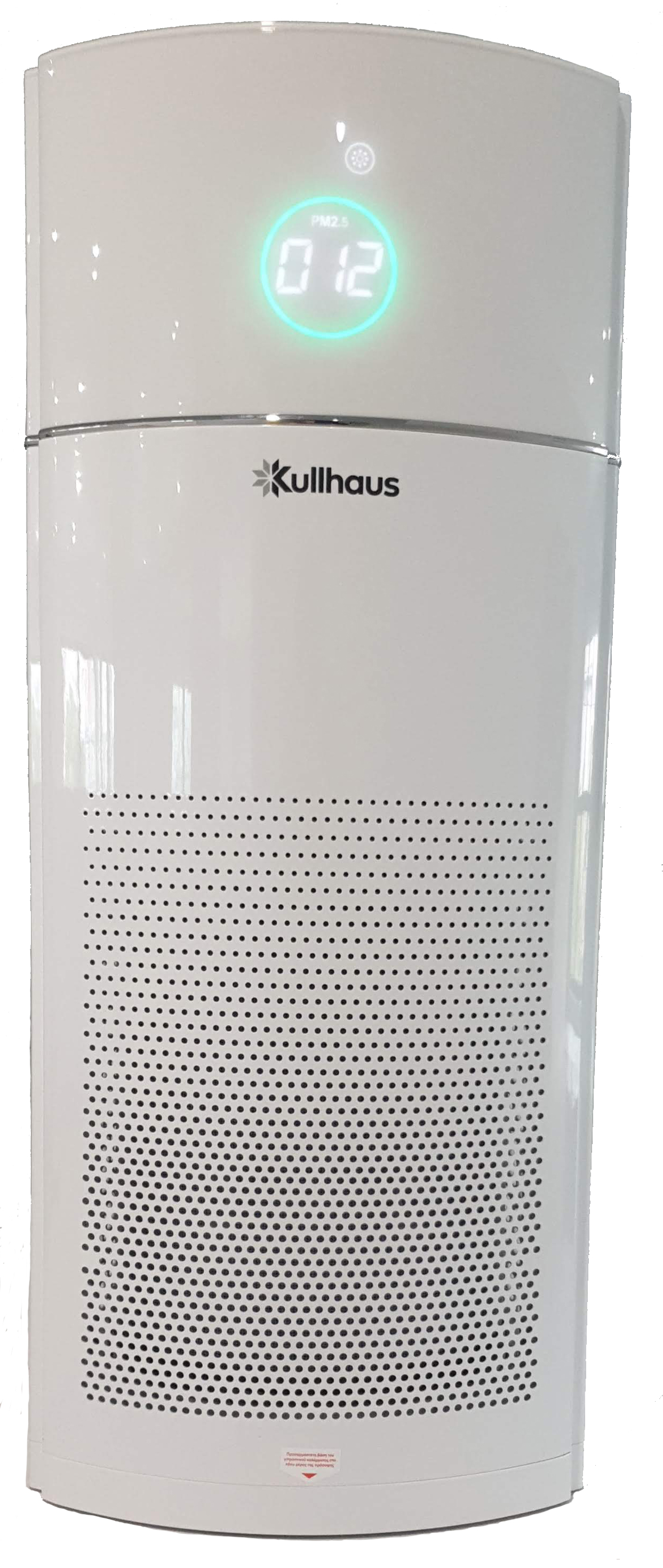
Clean air and quality of life
The air purifiers of Kullhaus AERO ionizers ensure that the room air will be free of airborne particles smaller than 0.3 microns.They ensure a healthy living environment and will make a real difference in the quality of your life at home or workplace.Kullhaus air purifiers fight pollen, cigarette smoke, dust, dust mites, mold spores, pollution, viruses and bacteria, VOCs, animal hair.
Just compare the CADR (CLEAN AIR DELIVERY RATE) results of Kullhaus air purifiers with other products of the European market.
CADR Results
| Model | space up to | CADR (m³/h) |
|---|---|---|
| AERO | 45 sq.m. | 370 |
| AERO+ | 60 sq.m. | 495 |
Number of air changes according to the Air Volume
Room air volume: Measure the length, width and height of your room in meters and multiply the three together to give you the cubic volume of the room's air [m³]. If the symptoms are mild, three times an hour, it will be fine, five times an hour, it will give better results. If your allergy is severe, you should calculate seven or eight times air change per hour.
| Model | Number of air changes per hour | |||||
|---|---|---|---|---|---|---|
| Kullhaus AERO | 3 | 4 | 5 | 6 | 7 | 8 |
| 124m³ | 93m³ | 74m³ | 62m³ | 53m³ | 46m³ | |
| Model | Number of air changes per hour | |||||
|---|---|---|---|---|---|---|
| Kullhaus AERO+ | 3 | 4 | 5 | 6 | 7 | 8 |
| 165m³ | 124m³ | 99m³ | 82m³ | 71m³ | 62m³ | |
You should know that the more times the room air passes through the Kullhaus ionizer air purifier, the cleaner it will be.

